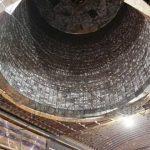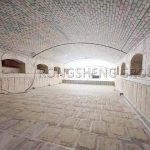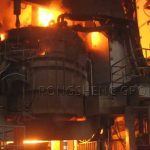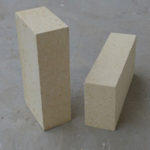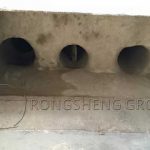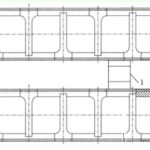The properties of silicon nitride-bonded silicon carbide bricks: They not only possess high density, high strength, good thermal shock resistance, high softening point under load, good thermal conductivity, and high resistivity, but also exhibit excellent resistance to melting and erosion by cryolite, aluminum fluoride, sodium fluoride, and calcium fluoride, as well as oxidation resistance. They are mainly used in building and sanitary ceramics, daily-use ceramics, electrical ceramics, aluminum, copper, and zinc smelting, steelmaking and rolling, ironmaking, metal heat treatment, and environmental protection.
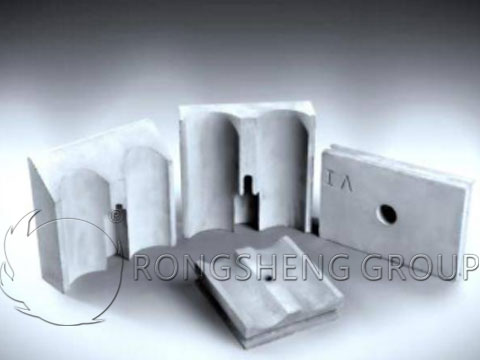
Performance of Silicon Nitride-Bound Silicon Carbide Bricks
The high-temperature flexural strength of silicon nitride-bound silicon carbide bricks is 4 to 8 times that of ordinary refractories. Its coefficient of thermal expansion is half that of high-alumina refractories. Its thermal conductivity is 7 to 8 times that of general refractories. Strength increases with temperature, but begins to decrease at 1400℃. However, it maintains its room-temperature flexural strength at 1500℃. The thermal conductivity of this material gradually decreases with increasing temperature. It features high density, high strength, good thermal shock stability, high softening point under load, good thermal conductivity, and high resistivity. It also exhibits excellent resistance to melting and erosion by cryolite, aluminum fluoride, sodium fluoride, and calcium fluoride, as well as oxidation resistance. Its performance is described below:
- 1) Silicon nitride-bound silicon carbide bricks are hard, with a Mohs hardness of approximately 9. Among non-metallic materials, it is a high-hardness material, second only to diamond.
- 2) Silicon nitride-bonded silicon carbide bricks have high strength at room temperature, maintaining almost the same strength and hardness at temperatures ranging from 1200 to 1400℃. Depending on the operating atmosphere, the maximum safe operating temperature can reach 1650 to 1750℃.
- 3) They have a low coefficient of thermal expansion and higher thermal conductivity compared to silicon carbide bricks, making them less prone to thermal stress, exhibiting good thermal shock resistance, and a long service life. They also possess strong high-temperature creep resistance, corrosion resistance, resistance to extreme cold and heat, oxidation resistance, and are easily manufactured into bricks with high dimensional accuracy.

Factors Affecting the Quality of Silicon Nitride-Bound Silicon Carbide Bricks
The main raw materials involved in the production of silicon nitride-bound silicon carbide bricks include silicon carbide, silicon powder, nitrogen, and other additives.
Unlike ordinary silicon nitride materials, silicon nitride-bound silicon carbide bricks require raw materials with higher purity. The purity of silicon carbide should reach 98.5% or higher, the purity of silicon powder should reach 99% or higher, and the purity of nitrogen should reach 99.9% or higher.
Besides strictly controlling the purity of raw materials, the particle size and particle size distribution of the raw materials also need to be strictly controlled during the production process. Excessively high particle size will directly affect the bulk density of the formed body, resulting in reduced compactness and affecting the final product quality.
Regarding the particle size distribution of raw materials, attention should be paid to the particle size of silicon powder. Controlling the particle size of silicon powder ensures the reaction efficiency between silicon powder and nitrogen, but excessively reducing the particle size of silicon powder will also have certain negative effects. Specifically, an excessively fast reaction rate between silicon powder and nitrogen will cause a rapid accumulation of heat in the reaction apparatus. When the temperature exceeds 1400℃, silicon flow will occur on the surface of silicon carbide, which is detrimental to product quality control.
Additionally, adding ZrSiO4 to the raw materials of silicon nitride-bonded silicon carbide bricks can improve the product’s oxidation resistance.
Binders for Silicon Nitride-Bound Silicon Carbide Bricks
In the production process of silicon nitride-bound silicon carbide bricks, temporary binders are required. The addition of these binders serves two main purposes: First, it helps the raw materials fuse to achieve a homogeneous body, improving the dispersibility of the raw material particles and creating favorable conditions for the forming of the brick body. Second, silicon nitride-bound silicon carbide bricks undergo heating during the drying and firing processes. Under high temperatures, the temporary binder disperses. The volatilization of gaseous substances leaves numerous network-like pore channels in the bricks. This not only facilitates nitrogen inlet and improves the reaction efficiency between silicon powder and nitrogen but also contributes to the stability of the final product. Common temporary binders include organic dextrin, calcium lignosulfonate, and dispersants from the German company Sima Chemical. Currently, the industry standard for the addition of temporary binders is typically less than 5% by mass.
Molding Process of Silicon Nitride-Bound Silicon Carbide Bricks
Currently, the molding processes for silicon nitride-bound silicon carbide bricks mainly fall into two categories: semi-dry molding and slip casting. Semi-dry molding is more widely used due to its higher production efficiency. Temperature and time significantly affect product quality during the drying process. Too low a temperature or too short a time will result in residual moisture in the brick body. This can induce oxidation of silicon powder during the subsequent nitriding reaction, reducing the nitriding efficiency and affecting product quality. The rate of temperature increase also impacts product quality. Too rapid a temperature increase makes it difficult to control the high-temperature environment. Excessively high temperatures can cause cracks on the surface of the brick body.
After the raw materials for silicon nitride-bound silicon carbide bricks are mixed and molded, they are fired at a high temperature of approximately 1400℃ in a nitriding furnace. The final product quality and appearance are closely related to the temperature of the nitriding reaction. The reaction between silicon powder and nitrogen gas generally involves two temperature stages: first, the heating stage, and then the nitriding reaction stage of the raw materials. During the heating stage, the temperature inside the device rises from the initial temperature to about 1100℃, while the temperature during the reaction stage of the raw material silicon nitride is between 1100℃ and 1350℃.

